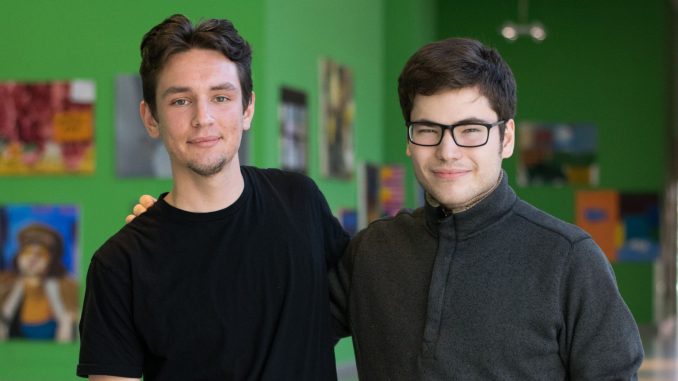
For some students, the best result of a month-long class project is a passing grade.
But graphic and interactive design seniors Luke Harding and Charles Attisano not only earned an A, but also won $2,500 for an animated video they created in the span of 31 days.
As part of a senior design seminar, Abby Guido, a graphic and interactive design professor, gave her students an assignment: enter the annual Temple Analytics Challenge, a university-wide contest where students submit a graphic analyzing data sets provided by Comcast, Pfizer and QVC. The challenge is organized through the General Education Program and the Office of the Senior Vice Provost for Undergraduate Studies.
Attisano and Harding entered and they found out they won on Nov. 13.
“It was exhilarating, kind of, even though we were completely on the run the whole month,” Attisano said.
Guido, who is also on the advising team for the challenge, said she wanted to build the challenge into her syllabus so her students would have dedicated class time to work on a time-consuming project.
“I love giving it to design students because…I like to challenge the students and show them that they too can analyze the data, even though it’s outside the realm of what they normally do,” she said. “But it’s a big undertaking, so I know the students who do it outside of coursework can be very overwhelmed.”
While most of Guido’s 25 students chose to create a “flat graphic,” a single picture with minimalistic graphic design which she originally assigned, Harding and Attisano went above and beyond.
“Animation is a lot more time-consuming,” Guido said. “I wasn’t being completely serious, but I threw it out there that if anyone wants to pair up and do an animation that I would allow that. [Harding and Attisano] took me seriously and took on the task.”
Harding and Attisano used data from Comcast to create a three minute-long video using animation and motion graphics to explain what makes a movie a “box office success.” They used animated movie reels and tickets to draw graphs showing the financial costs and other factors that contribute to the success of a film.
What would normally be a semester-long project, Guido said, was accomplished in four weeks. Because the deadline was so short, Harding and Attisano worked “nonstop.”
Harding and Attisano spent the first two weeks analyzing the Comcast movie data, drafting the script for their video and planning how they would animate the video. Harding worked on the graphics while Attisano focused on animating them.
Their video’s style was inspired by Vox, an online news website that creates animated infographic videos with voiceovers.
During their weekly class meetings, Guido would look at Harding and Attisano’s progress. She was “very impressed” with their work and offered critiques and suggestions. Because they were on such a tight schedule, she wanted to make sure they created something that was advanced and worth their time.
“There was a moment in week three when they presented and I gave them a bunch of feedback, and I could feel Charles glaring at me,” she said. “It’s easier to make a change on a flat graphic than it is in the animation and I think he was adding up the hours it would take to incorporate the changes.”
The class critique sessions really helped Attisano when he was working on the video because he had a place to get feedback, he said.
When their project made it among the finalists, Harding said he and Attisano were “hopeful” they would place in the competition. When the announcement came that they had won first place, they were both excited and relieved, Harding said.
“It was pretty cool,” Harding added. “All the hard work paid off. It was nice to get recognized.”
“It was kind of reassuring,” Attisano said. “Knowing that taking the initiative to animate it had paid off in the end, it was exciting.”
One of the judges for the analytics challenge told Harding that he was impressed by the way their entry showed the data in a clear way.
“That’s kind of something that we learned throughout the process,” Harding said. “No matter how well you analyze the data, if you don’t communicate it effectively, it doesn’t really matter. You can do all this ridiculous analyzing, but as designers, we’re also storytellers.”
Harding is unsure how he’ll use his prize money, but Attisano said he will use it to purchase graphic design software or for living costs after graduation. Both want to pursue data visualization in their future careers.
“We got an A,” Harding said. “But we didn’t do it just for the competition, we did it because we really like animation.”



Be the first to comment